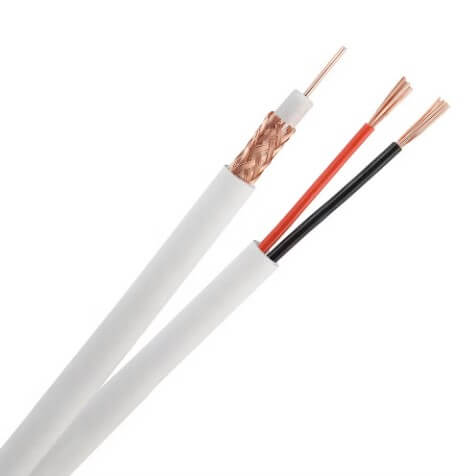RG59 cable
RG59 cable is a type of coaxial cable widely used in the installation of analog cameras and AHD (Analog High Definition) CCTV cameras. Its design makes it ideal for transmitting video signals over short to medium distances, making it a staple in many video surveillance systems.
Structure and Components of RG59 Cable
The RG59 cable consists of several layers crucial for delivering clear video signals:
- At the core is the inner conductor, typically made of copper or copper-clad steel, which carries the video signal from the camera to the recording device.
- Surrounding this conductor is the dielectric insulator, which prevents signal loss and interference by maintaining proper spacing.
- A braided metal shielding layer encases the dielectric, protecting against external noise and electromagnetic interference that can degrade video quality.
- The outermost layer is a durable plastic jacket that protects the cable from physical damage.
Proper cable management during installation is essential to preserve the cable’s shielding and avoid damage, which can cause signal degradation.

Use of RG59 in CCTV Systems
RG59 coaxial cable is most commonly used with analog cameras, including AHD models, connecting them to a monitor or Digital Video Recorder (DVR) via BNC connectors. These connectors are attached to the cable ends using tools such as a compression tool or crimping tool, ensuring a secure, low-resistance connection for optimal signal transmission.
For installations requiring both video and power over a single cable, Siamese cables — which combine RG59 coaxial and power wires — are frequently employed. To extend video signals over longer distances or convert between cable types, baluns are used to adapt RG59 coaxial cables to twisted pair cables like Cat5e or Cat6.
Technical Considerations
- Impedance matching is critical in CCTV installations to prevent signal reflections and loss. RG59 cable has a characteristic impedance of 75 ohms, matching most analog camera systems.
- Improper grounding or cable layout can cause a ground loop, which introduces unwanted rolling bars or flickering on the video signal.
- Interference and noise can also result from poor shielding or running coaxial cables too close to power lines or other sources of electromagnetic fields.
- Use of proper butt connectors and maintaining cable integrity during installation helps minimize troubleshooting efforts later on.
Installation and Troubleshooting Tips
When installing RG59 cables:
- Avoid tight bends to prevent damaging the dielectric and conductor.
- Ensure all BNC connectors are properly secured with the right compression or crimping tools.
- Maintain good cable management practices to prevent tangling or damage.
- Use a cable tester to check continuity and identify faults quickly.
- If experiencing video quality issues such as noise, flickering, or loss of signal, check for ground loops, loose connections, or damaged cables.
Advantages
RG59 is favored for its flexibility, ease of use, and cost-effectiveness in CCTV systems using analog cameras and AHD technology. Its compatibility with Siamese cables simplifies installations by combining power and video transmission in one cable.
Limitations
While RG59 is excellent for short to medium cable runs, it has limitations:
- It is not ideal for long-distance runs beyond 300-500 feet without signal boosters.
- Compared to RG6 or modern network cables (used for IP cameras), RG59 has lower bandwidth capacity and higher signal loss.
- Vulnerable to interference and noise if not properly shielded or if poorly installed.
- Less suitable for newer digital and IP camera systems that require network cabling standards like Cat5e or Cat6.
Understanding RG59 coaxial cable and its associated components — including BNC connectors, baluns, and tools like the compression tool and crimping tool — is fundamental. With proper cable management, attention to impedance matching, and awareness of common issues like ground loops and interference, RG59 remains a reliable and cost-effective choice for analog and AHD CCTV camera installations.
Mastering RG59 cable installation and troubleshooting will provide a solid foundation for anyone starting a career in CCTV installation and maintenance.
Our trusted customers











